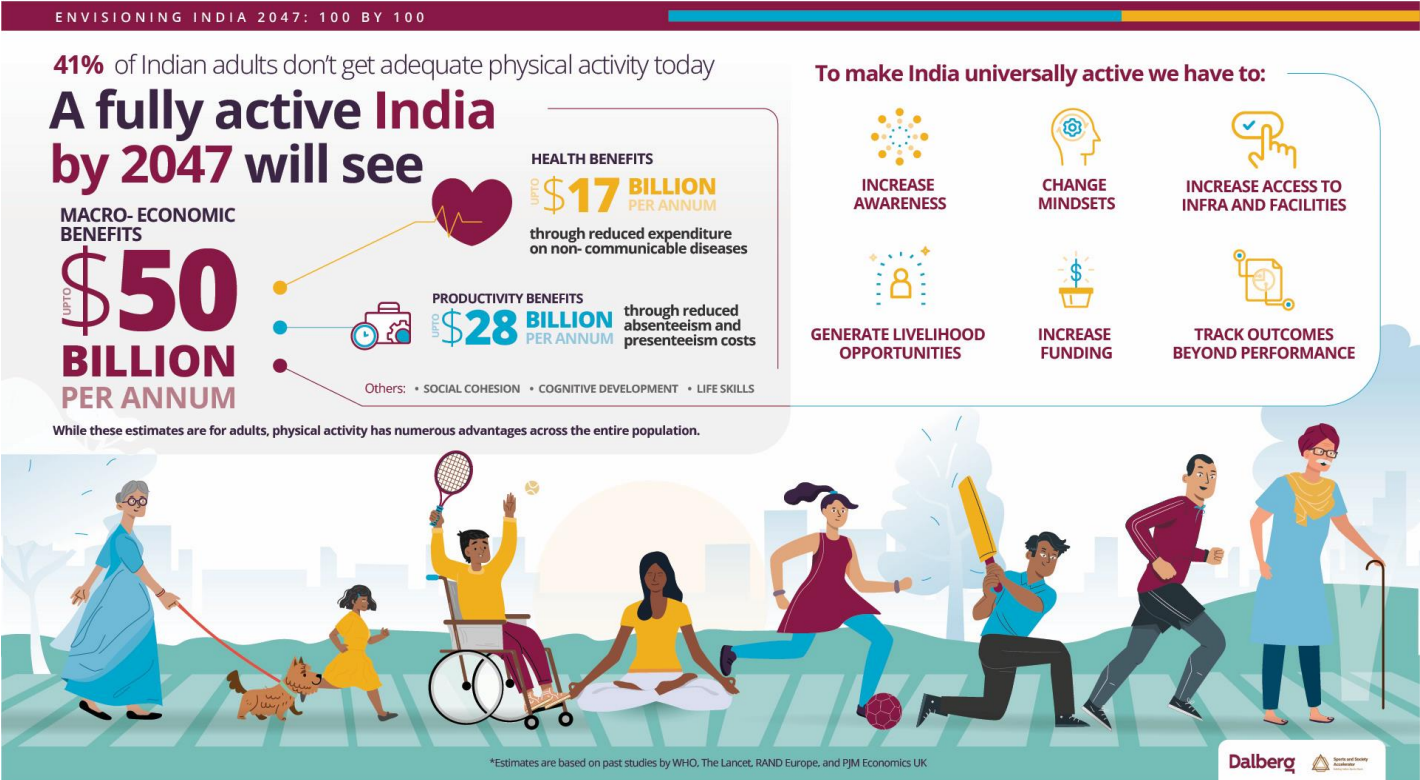Dalberg uses cookies and related technologies to improve the way the site functions. A cookie is a text file that is stored on your device. We use these text files for functionality such as to analyze our traffic or to personalize content. You can easily control how we use cookies on your device by adjusting the settings below, and you may also change those settings at any time by visiting our privacy policy page.
How valuable is physical activity to the economy? A pioneering study by Dalberg alongside Sports and Society Accelerator is measuring the impact in India. Here are our preliminary findings.
If every adult in India were to shun a sedentary lifestyle by 2047, the annual GDP stands to gain $50 billion. This means every percentage drop in inactivity would yield between $1-1.25 billion in 2047’s economic output. The $50 billion sums up the proceeds from a range of benefits, including health, productivity, and social cohesion. Roughly $17 billion yearly will come from health outcomes since less will be spent on noncommunicable diseases (NCDs), a key cause of mortality nationwide. An ensuing spike in workforce productivity should fetch a further $28 billion.

These are conservative estimates from the ongoing State of Play initiative — a novel research study into the socioeconomic returns accruing from physical activity and sports. Led by Dalberg Advisors in collaboration with Sports and Society Accelerator, the initiative aims to create India’s first data-driven baseline on the impacts of physical activity. It will also highlight gaps that need to be plugged to realize physical activity gains, along with global best practices that can be adapted. The right enablers could make India well-placed to be the world’s first country to have universal physical activity.
An opportune time for India
India’s rich sporting culture offers avenues to promote universal physical activity as a health, education, and economic tool with downstream advantages to youths and adults — especially in view of the country’s centennial anniversary in 2047. Traditional exercises like yoga, as well as sports like kabaddi and kho-kho can be used to target health and productivity parameters in an inclusive way. India is also poised to lead a physical activity agenda on the international stage.
With its current presidency of the G20, its decades-long demographic dividend, and its growing focus on health and fitness, India could be a global beacon for universal physical activity.
Achieving this goal will mean overcoming challenges. For example, a 2022 World Health Organization report showed that more than 70% of India’s adolescents are inactive, and NCDs maintain a 66% mortality rate across the population. The government will need to complement the efforts of states like Haryana and Odisha, and implement federal programs that help people recognise and reap physical activity rewards. Underlying this push will be a need for data-backed understanding of the State of Play in India, and frameworks that track progress.
Figure 1: India’s NCD mortality and physical activity profile1

What’s next?
Over a series of releases, the State of Play initiative will add to the existing foundation of benchmarking and sector learning in six ways:
- Add nuance to the definition and understanding of adequate physical activity in the Indian and developing country context.
- Develop a holistic framework linking sports and physical activity to socio-economic benefits.
- Complete a detailed mapping of opportunities and participation in physical activity across India.
- Undertake a first-of-its-kind estimation of the economic benefits of increased physical activity in India.
- Deep dive into behavioral and mindset challenges and barriers.
- Issue a clear call to action and roadmap to the sector, with clear roles and responsibilities for its main stakeholders.
Physical activity, sports, and play are goals everyone can get behind. They also hold tangible benefits. Building on the foundational initiatives that exist, the State of Play can help India reach universal physical activity by 2047. There is no better time to start than now.
Read our full brief.
-
1
“India’s Physical Activity Profile,” WHO (2022) https://cdn.who.int/media/docs/default-source/country-profiles/physical-activity/physical-activity-ind-2022-country-profile.pdf?sfvrsn=4208cb78_5&download=true

